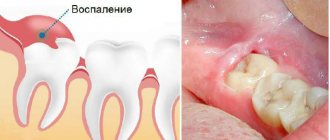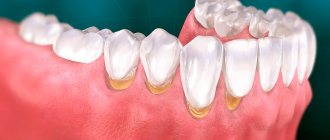For many people, wisdom teeth have difficulty erupting because they do not have enough space in the jaw. In this case, dentists recommend removing them to prevent crooked teeth and other problems. Extraction of third molars is a complex operation that must be performed by a highly qualified dental surgeon.
After surgery, it is important to follow your doctor's recommendations.
- For the first few days after surgery, you should not rinse your mouth or drink through a straw, as this may wash out the blood clot covering the wound.
- Brush your teeth with a soft-bristled brush and eat only soft foods to avoid damaging the socket.
- Minimize physical activity, do not visit the sauna or take a hot bath.
- If the pain is severe, take painkillers. To relieve swelling, you can apply ice to your cheek.
- Stop drinking alcohol and smoking.
It is important to monitor the wound remaining at the site of the extracted tooth until it heals completely.
What does the white coating mean?
Did you find that your gums turned white after wisdom tooth removal? There is no cause for concern as this is normal. White plaque may be on the hole and around it. The reason for its appearance is fibrin, a protein that ensures tissue regeneration. It performs several functions:
- prevents bleeding,
- closes the wound and protects it from bacteria,
- helps reduce the diameter of the hole,
- accelerates the resorption of a blood clot.
White plaque cannot be removed. Because of this, pain increases and the wound healing time increases. Damage to the protective film can lead to severe bleeding and infection of the socket.
Questions about prosthetics
Elena
2018-11-17 15:17:00
Hello! I have had temporary plastic crowns for a year and a half now, 8 teeth on the upper jaw and 5 below. The teeth are all cured, some have inlays. These crowns have already been removed and filed several times, the top one is already broken, they glued it together. The orthopedist is in no hurry to do his job, makes an appointment once every month and a half. About five months ago, I began to experience constant itching and a feeling of fullness in the upper jaw, in the place where the crowns are located. Two months ago, it became painful to press on the gum above one tooth, there was no redness as such, and until recently I had a rash on my wrists and elbows, it went away after taking enterosorbents. I have a general malaise and my lips are constantly dry, maybe it has nothing to do with the problem of my teeth. The doctor himself says that wearing plastic is very harmful and at the same time it’s dragging. the itching was bothering me. I have a question for you, is this an inflammatory process or what could it be? I read that plastic releases a monomer that has a toxic effect. What can be done in my case. Thank you if you don’t ignore my question
Shinberg Oleg Emilievich
chief consultant, orthopedic dentist
Dear Elena, it is indeed very harmful to use temporary plastic crowns made by polymerization for a long time, and indeed, they emit a monomer that is harmful to the gums. Therefore, it is completely incomprehensible to me why your doctor is delaying so long with the manufacture of permanent structures. At a minimum, it is necessary to replace your temporary crowns with temporary crowns made by milling. They do not release monomer, because blanks for milling are made in the factory. Unfortunately, I can’t give any more advice without an examination and consultation, since the cause may not be isolated. In any case, I recommend changing your dentist, because, for some reason, he is clearly not interested in you.
Natalia
2018-10-05 17:02:00
Good afternoon, the 5th tooth is broken, only the root remains. What can be done with it? Or just an implant? Tooth from above
Shinberg Oleg Emilievich
chief consultant, orthopedic dentist
Dear Natalya, in your case there are two options: either tooth extraction followed by implantation and making a crown, or preserving the tooth root and then making a crown. This will depend on the level of the root fracture. Unfortunately, it is impossible to answer the question more accurately without consultation and an x-ray.
Natalia
2017-12-07 18:06:00
Good afternoon I am replacing the upper chewing teeth. It is necessary to place 4 units on teeth 14,15,16,17. The doctor recommends all-ceramic veneers. Initially they planned simple crowns, but today I’m convinced. I doubt it. I read that it is not advisable to put veneers on chewing teeth: they are expensive and less reliable. Is that true? There are no problems with gums or allergies to metal ceramics. The price of a veneer is of course more expensive. Thanks in advance for your answer.
Shinberg Oleg Emilievich
chief consultant, orthopedic dentist
Dear Natalya, good afternoon! The advantage of veneers over crowns is that they require much gentler preparation. Veneers, unlike crowns, do not cover all surfaces of the tooth and the thickness of the walls of the veneer is much thinner than the walls of the crown. As for the reliability and strength of veneers, modern materials make them even more durable and reliable than those on a metal-ceramic crown. Therefore, contraindications for installing veneers on chewing teeth are no longer relevant today. Of course, the price of a veneer is higher than that of metal-ceramic crowns, but the price is compensated by the greater reliability of the veneer and the durability of the structure.
Catherine
2017-11-07 20:52:00
Hello! I would like to know how much it will cost to install ceramic veneers? Thank you.
Shinberg Oleg Emilievich
chief consultant, orthopedic dentist
Good afternoon Ekaterina! The cost of making a ceramic crown (veneer) is 54,000 rubles.
Varvara
After visiting the dentist, it turned out that I would have to have a sinus and implantation of 2 teeth. I'm terribly afraid of the dentist, but I still have to do it. I’ve heard a lot about dental treatment in a dream, but I don’t quite understand how this happens and what the consequences might be after this method of treatment. I would like to consult an experienced specialist on this issue. Tell me if there are any contraindications for carrying out such a procedure and whether you will feel lethargic and drowsy afterwards. I drive all the time, so I want to know if I will be able to drive a car after leaving the office and how will I feel after that?
Shinberg Oleg Emilievich
chief consultant, orthopedic dentist
Dear Varvara, treatment in dreams really does exist, and indeed this method can almost completely relieve stress from people who, like you, are terrified of the dentist. The procedure takes place with the participation of an anesthesiologist and is completely safe. As for the question of being able to get behind the wheel immediately after leaving the office, this is categorically not recommended.
Possible complications
In rare cases, white gums after wisdom tooth removal may indicate the development of complications.
- Alveolitis. Inflammation of the socket due to infection by pathogenic microorganisms. The causes of development include non-compliance with personal hygiene rules and doctor’s recommendations. The main clinical manifestations are throbbing pain, gray plaque on the wound, and swollen lymph nodes.
- Periostitis. Inflammation of soft tissues and periosteum. Develops due to poor quality dental treatment and jaw injuries. It is a small growth on the gum that can be red, yellow or white.
Are white spots always associated with the installation of implants?
The appearance of a white film or spots on the oral mucosa is associated with a number of diseases.
Lack of calcium in the body . If a lack of calcium has caused tissue discoloration, then a review of the diet, as well as additional intake of calcium-containing medications, will help cope with the problem. Consultation with a doctor is required.
Zhiroviki . White spots on the gums are benign growths. There is no danger in them, however, an intensive increase in the size of the lesions should alert you and become a reason for an urgent visit to the clinic. Under no circumstances should you crush or burn them. This pathology often occurs in children. It goes away on its own without treatment.
Stomatitis . A common disease that occurs in adults and children. Its peculiarity is that the gums acquire a grayish-white tint due to the purulent plaque that appears on them. Stomatitis is not dangerous and can be easily treated by rinsing the mouth with antiseptic solutions and applying a special ointment to the gums. It is also recommended to follow a diet that excludes sour, spicy and salty foods.
Candidiasis (thrush) . The disease affects adults and children with reduced immunity. The cause of white plaque is the active growth of fungal bacteria on the mucous membrane. Thrush often develops while taking antibiotics due to a violation of the microflora. Treatment consists of taking antifungal agents and treating the oral cavity with antiseptics.
Tooth cyst . A white pimple on the gum may indicate an inflammatory-purulent problem in the area of the tooth root. Only a doctor can determine whether this is really the case based on an x-ray.
Periodontitis . It appears as a white spot on the gum, which occurs as a result of the formation of a fistula with purulent contents.
Leukoplakia . Characterized by keratinization of the mucous membrane. Treatment of the disease is aimed at eliminating the irritating factor. After it has been identified and eradicated, the stage of medicinal treatment begins, including rinsing with celandine infusion, 10% salicylic acid solution, and taking vitamin complexes. The pathology is quite dangerous and is a precancerous condition that requires qualified attention. The risk of leukoplakia becoming malignant is from 15 to 75%, depending on the degree of complexity of the disease.
Pathology can develop due to improper oral hygiene. Daily care helps prevent many problems. However, there must also be a rational approach here. Excessive abuse of hygiene products (creams, ointments, rinses) is fraught with an imbalance of microflora.
In cases where dental implantation has taken place, whitish gums may be a sign of implant rejection. You should consult a doctor immediately. The symptom may not be directly related to the implantation of the artificial root, but its occurrence can greatly complicate the recovery process.
How to treat if your gums are white
White plaque, ulcers, and pimples on the gums are accompanied by an inflammatory process. Only a doctor can reliably determine the cause of the problem and prescribe the correct treatment. It is good if this is done at the initial stage of the disease to avoid serious complications.
The patient examination consists of:
- inspection;
- radiography of the jaw;
- computed tomography;
- blood tests.
An uncomplicated degree of the disease may be limited to local therapy (antiseptic, antibacterial agents). Advanced cases require surgery with a long rehabilitation period.
Only a doctor should make a diagnosis and prescribe treatment. “Grandma’s methods” are good as prevention.
Disease Prevention
- Use of special hygiene products: toothbrush, toothpaste, floss. It is good if these elements are selected together with the dentist.
- Daily brushing of teeth in the morning (after breakfast) and in the evening (before bed).
- Balanced diet. It is not recommended to overuse flour products, sweets, and spicy foods. It is important that the food is at normal temperature. Too hot and too cold negatively affect the health of your gums and teeth. Fresh vegetables and fruits in your diet will only be beneficial.
- To give up smoking. Periodontal disease is a common problem among smokers. When you inhale tobacco smoke, the blood vessels in the oral mucosa narrow, which significantly impairs blood circulation.
- Use of rinses and dental gels. The procedures help avoid the development of microbes in places that are difficult to reach with a toothbrush.
- Regular visits to the dental office, preventive teeth cleaning.
- Complete restoration of the dentition in just 4 days!
more detailsRoott Pterygoid Implants Sinus lift is no longer needed!
more details
Once and for life! Express implantation in 4 days with a permanent ReSmile prosthesis
more details
All-on-4, All-on-6, ReSmile, Zygomatic implantation We use all modern methods of dentition restoration
more details
When do you need a doctor's help?
If you experience pain 3-5 days after wisdom tooth removal, you should consult a specialist. Reasons to visit a dentist are also:
- accumulation of pus in the wound,
- bad breath,
- increase in body temperature,
- bleeding gums,
- swelling of the lip or cheek,
- pain when eating.
Don't expect unpleasant symptoms to disappear. Contact your doctor even if you experience minor oral discomfort.
Now about the production of metal ceramics in our clinic
Temporary crowns are made for you before preparing your teeth so that you don’t walk around for a single day with ground-down “stumps” that scratch your tongue and lips and frighten those around you. The doctor carefully, and therefore slowly, fits these crowns to your teeth and gums. Yes, yes, even temporary crowns should under no circumstances irritate the gums. And this is achieved by high-quality, which again means quite a long work, by preparing the teeth, with their obligatory polishing and smoothing of the ledge, designed to protect the gums from the pressure of the crown.
Impressions for permanent crowns are taken using modern, absolutely painless gum retraction technology of the 21st century - the gums are moved back not with a traumatic retraction thread, but with a special composition that does not cause the slightest pain. The quality of the impression material plays an important role at this stage.
When your new teeth are ready, they must be tried on, taking into account your wishes; the fit of the crowns to the ledge and gum is very carefully checked in order to exclude any pressure on it, as well as contacts with neighboring teeth so that they are tight and pieces of food do not fall between the teeth ( a very common mistake when making crowns). The crowns are then fixed to temporary material so that the color, shape and ease of use can be checked in natural conditions. If necessary, the crowns are adjusted, achieving absolute harmony and comfort. And only after some time the metal ceramics are fixed with permanent cement.
Of course, all these manipulations take time, and high-precision technologies that guarantee quality, by definition, cannot be cheap.
You wouldn’t believe it if they offered you to buy “a car for the price of a bicycle”? What is the difference between metal-ceramic crowns?
Do you want to buy something inexpensively that you simply won’t be able to use in the future?
After all, as more than 20 years of practice and simple mathematics show, the production of cheap metal ceramics, which is promoted on every corner, is much more expensive. And not in the distant future, but in the quite foreseeable.
Leukoplakia
You may be interested: 8 main enemies of tooth enamel
With oral leukoplakia, uniform white spots may appear on the gums. The cause of this condition is unclear, but alcohol, smoking and poor oral hygiene are suspected to be to blame. In most cases the condition is harmless, but sometimes it can become cancerous over time.
What do pale gums on a dog mean?
Healthy mucous membranes
The color of a dog's gums is one of the most important indicators of a pet's health.
The gums play the role of a protective barrier in the dog's body. If you feel well, your gums will be pink or light pink. However, if your dog is feeling unwell, changing gum color can help spot and prevent the threat. Examine your pet's healthy gums while the dog is awake and at rest. Take a good photograph of your gums in good lighting. This way, if there are problems, you can quickly demonstrate to your veterinarian why the color of your gums is causing you concern.
Each dog's gum color is different. If, in good health, the gums of your four-legged friend are not pink, but slightly darker or lighter and have always been this way, then this is the norm specifically for your pet. Many dogs have partially dark gums; in this case, use the color of the unpigmented areas as a guide.
Check your dog's gums and teeth regularly. Healthy gums feel moist and slippery to the touch. When you press on the gum, it turns pink again within two seconds. This is a sign of good capillary circulation.
Not only gums and oral tissues, but also other mucous membranes can tell about the dog’s condition. If you suspect something is wrong, evaluate the appearance of the visible mucous membranes of the pet’s eyes, ears and genitals.
When you need urgent help
What does pale gum color on a dog mean? About the need to assess her well-being: are there any other alarming symptoms, were there any injuries or incidents that could harm your pet? If the gums are unhealthy, exclude rough and cold foods from his diet.
Pale gums in a dog are not a disease, but a possible signal of illness. The diagnosis can be made by a veterinarian based on a combination of symptoms, tests, examinations, and the patient’s medical history.
Pale gums can be a symptom of many different diseases. This list includes heart failure, gastric dilatation, and the presence of a foreign body in the respiratory tract. Therefore, it is important to understand exactly what reason affected the appearance of the gums.
White gums may indicate anemia (anemia), as well as blood loss, internal bleeding, intoxication, infection with internal parasites, insufficient oxygenation of the blood, or lack of hemoglobin, an iron-containing blood protein. Gum color that is too light in dogs can be caused by pneumothorax, an accumulation of air in the pleural cavity that interferes with normal lung function and gas exchange during breathing.
Pale gums may be accompanied by lethargy, apathy, poor appetite, refusal to walk and play, cough, shortness of breath, and changes in body temperature. Such symptoms indicate that the dog urgently needs to be shown to a veterinarian. An unnaturally light color of the gums may indicate a pet’s deep state of shock - in such a situation, the help of a doctor is also needed. You won't be able to figure out what's wrong on your own. Therefore, take your pet to a veterinarian as soon as possible.
If your pet loses consciousness, first call your veterinarian and describe the situation. The specialist who sees your pet will instruct you on the necessary measures.
Delay and attempts to independently help your pet at home are extremely dangerous. But if your pet cuts itself, then before visiting a doctor you should treat and bandage the wound to stop the bleeding.
Mandatory visit to the veterinarian
If your dog is alert, active, sociable and eating well, pale gums will still be a sign that you need to take your pet to the veterinarian. Not urgently, but in the near future. It can be assumed that in this case we will talk about replenishing the lack of vitamins in the body and preventive measures. Sometimes the prerequisites for the development of anemia in a pet are a lack of iron and folic acid.
Be careful when walking your dog. The gums may become pale if the pet is cold and if the dog eats snow. If after a walk in frosty weather your dog’s gums turn pale, take him into a warm room, warm him up, and give him a warm drink. Place a heating pad or a bottle of warm water under your side. Stroke the dog's fur, calm it down, talk to it kindly. If it is only a slight hypothermia, the gums will soon return to a healthy pink color.
We wish your pets health!
When white plaque on a wound after tooth extraction requires examination by a doctor
Despite the fact that white plaque after wisdom tooth removal is a natural reaction, the patient needs to conduct a daily self-examination of the oral cavity and consult a doctor for help if alarming symptoms appear.
You should consult a doctor if:
➢
on the 3rd - 4th day the pain does not decrease, it becomes throbbing and intense;
➢
a white, reddish or yellow mass or liquid is released from the wound;
➢
swelling of the gums has intensified or spread to the face;
➢
body temperature rose above 38 degrees.
These signs indicate possible infection or complications. After examining the oral cavity, the dentist, if necessary, may prescribe a course of antibiotics or surgical cleaning of the socket cavity.
Possible reasons
As a rule, red gums indicate the development of gingivitis. This is a common disease characterized by inflammation of the gum tissue. It develops as a result of non-compliance with the rules of oral hygiene. Due to irregular brushing of teeth, soft plaque accumulates on them, which is an ideal environment for the proliferation of pathogenic bacteria. If it is not removed in time, it turns into tartar, which injures the mucous membrane.
Red gums are not always a symptom of a serious illness. It can also be associated with eating hard foods and scalding drinks, using too hard a brush, wearing dentures, braces, mouthguards, plates and other structures. A dentist will help determine the exact cause and eliminate the problem.
Diagnosis and treatment
A dental therapist can diagnose inflammatory gum disease and provide first aid. At the appointment, the doctor will collect an anamnesis, examine the oral cavity, conduct an instrumental examination and, if necessary, send for radiography. The treatment regimen for gingivitis is compiled individually for each patient. What might it include?
- Professional oral hygiene. Air Flow hardware cleaning is one of the most effective methods of combating tartar, soft plaque and other deposits.
- Mouth rinse. Antiseptic solutions reduce pain, relieve inflammation and prevent the proliferation of pathogens.
- Taking antibiotics. If a bacterial infection has joined the inflammation, the doctor may prescribe antibacterial drugs, ointments and gels.











